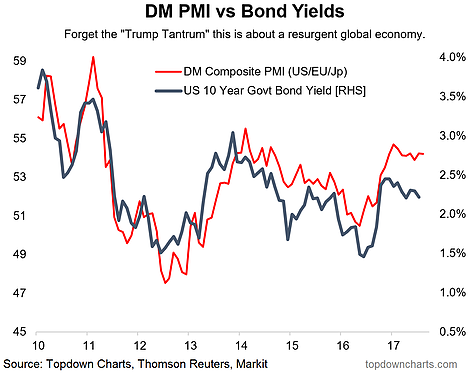The August round of flash manufacturing PMIs saw the composite DM flash PMI basically unchanged. This was the product of stronger results in Europe (57.4 vs 56.6) and Japan (52.8 vs 52.1) vs a disappointing US (52.5 vs 53.3)… although the US services PMI rose to a 28-month high of 56.9.The flash manufacturing PMIs from Markit provide a timely view on the most cyclically sensitive part of the economy, and taking a composite view as we do helps provide insight into some of the overarching global macro currents. At a composite view the theme of consolidation at solid levels following the synchronized upturn in 2016 remains in place, and points to ongoing economic expansion.
One of the key implications of the latest round of flash PMI data is the outlook for bond yields. The DM composite flash manufacturing PMI provides a fairly useful guide on the direction of bond yields, and with good reason. At present the chart looks to be suggesting upside in the order of 50bps for US 10-year treasury yields. At this point I would direct the attention to the second chart which shows the major DM components – the standout there is the Eurozone indicator, and indeed it will likely be the Eurozone which is in the driver’s seat of the global bond market. As mentioned elsewhere, with bond market volatility close to record lows, the actual risks for bonds look to be rising.
The DM composite manufacturing PMI, which is made up of all the flash results – effectively a global flash manufacturing PMI – held steady in August and still points to higher bond yields.

By component, there’s two different stories playing out within developed economies, with US and Japan leveling out and Eurozone strengthening. Ultimately this means the Eurozone will likely be in the driving seat of global bond yields.













Leave A Comment